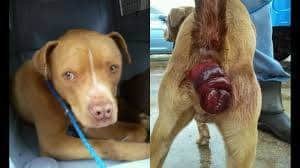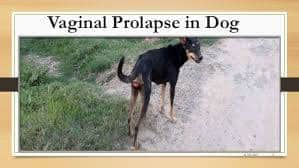VAGINAL PROLAPSE IN DOG
Compiled & shared by- DR Amit Bhardwaj, Small & Large Animal surgery expert,Pune.
Vaginal hyperplasia and prolapse refers to a mass which protrudes from the vaginal area. The condition is similar in nature to fluid-filled tissue (edema).
Discovering a large mass of tissue protruding from a dog’s vulva is alarming. To those unaware of vaginal prolapse, the mass may appear to be a fast-developing tumor, or an in-process miscarriage. As unsightly as it may be, the condition of vaginal prolapse commonly occurs in female dogs that have not been spayed. Due to the action of the female hormone estrogen, the tissue of the internal vaginal walls swells and protrudes through the vulva, the external female genital organ. The mass is usually accompanied by vaginal discharge. In vaginal prolapse, the swollen, protruding vaginal tissue resembles what’s often described as a “donut-shaped” mass. While the primary cause of vaginal prolapse is estrogen stimulation, other causes include vaginal hyperplasia (a proliferation of the vaginal mucosa) and genetic predisposition. Other causes of prolapse are prolonged straining resulting from a difficult labor and delivery, or an interruption during coitus before mating can occur. Reluctance to breed may be a symptom of vaginal prolapse. While the condition affects a range of dogs, breeds most commonly affected include Labrador and Chesapeake Bay retriever, English Bulldog, German Shepherd, St. Bernard, Mastiff, Springer Spaniel and Weimaraner. Predominance in certain breeds suggests that genetics plays a key role in the development of canine vaginal prolapse. When serious, vaginal prolapse may prevent urination. The condition is almost always diagnosed just before or during estrus (heat). While the outcome is positive for most animals, the chance of the condition recurring throughout pregnancy, or at the delivery is quite possible. Because breeding may place the dog at further risk for the condition, spaying the animal may be recommended. Vaginal prolapse, a condition caused by the action of the female hormone, estrogen, occurs in young, unspayed female dogs.
Symptoms of Vaginal Prolapse in Dogs
The most obvious sign of vaginal prolapse in a dog is the protrusion of tissue from the vaginal opening. This tissue will appear pink and inflamed. The dog may resist mating, even as she approaches or ensures her heat cycle. Dogs suffering vaginal prolapse may experience pain and discomfort with urination, and may lick frequently at the genital area.
Types
Type 1 occurs when there is a slight protrusion, even though it does not exit the vulva itself Type 2 is when the vaginal tissue protrudes through the vulvar opening Type 3 hyperplasia refers to the donut-shaped mass, which can be seen externally
Causes of Vaginal Prolapse in Dogs
Vaginal prolapse in dogs is a condition in which the tissue of the internal vaginal walls swells and protrudes through the vulva, or vaginal opening. Often, the entire vagina protrudes through the vulva. The prolapsed organ may look like a donut.
Some breeds may be more prone to vaginal prolapse than others.
These breeds can include:
• Boxer
• Mastiff
• German Shepherd
• Weimaraner
• Labrador Retriever
• St. Bernard
• Airedale Terrier
• English Bulldog
• Springer Spaniel
• Walker Hound
Genetics isn’t the only factor that can influence the development of canine vaginal prolapse. Vaginal hyperplasia, a condition which can cause inflammation of the vaginal wall, may lead to vaginal prolapse. Difficult urination and constipation can cause excessive straining that contributes to the condition. Dogs who experience a difficult labor may be more likely to suffer vaginal prolapse.
Interrupting a pair of dogs while they are mating can contribute to vaginal prolapse, if the male dog is forced to remove himself from the female before mating is complete.
Dogs who develop this condition usually haven’t been spayed, and are usually young. Vets have linked vaginal prolapse to elevated estrogen levels in the dog’s body, because the condition is most likely to occur right before the dog enters her heat cycle, or during the heat cycle itself.
Diagnosis of Vaginal Prolapse in Dogs


A veterinary consultation will be required for diagnosis of vaginal prolapse. The timing of the problem (during pre-estrus or estrus), and the typical appearance of the mass upon physical examination, will usually be sufficient for diagnosis. In an older female dog, a tissue sample is often taken to differentiate the condition from a cancerous growth. Aside from the physical examination, your veterinarian may choose to perform blood tests and urinalysis to rule out the presence of other underlying conditions or infection that may be present.
Differential Diagnosis
Vaginal edema and vaginal fold prolapse can be confused with a tumor, such as a steeled fibroma or leiomyoma. These types of tumors may be observed partly outside the vulva during estrus in the older bitch, while vaginal fold prolapse is generally observed during the bitchís first or second estrus. In addition, the prolapse originates from the ventral floor of the vagina cranial to the urethral orifice and it regresses at least partially during the luteal phase, which is not the case with tumors. In addition, a true vaginal or a uterine prolapse, which mainly occurs during parturition or shortly after, can be confused with a vaginal floor prolapse.
Treatment of Vaginal Prolapse in Dogs
Treatment depends on the extent of the fold prolapse, whether one is dealing with a breeding or non-breeding bitch and whether or not the prolapse is present during estrus or at the end of pregnancy. If in exceptional cases a fold prolapse develops just prior to whelping, there is in general no need for treatment and parturition can take place without problems .
In pro-estrus or estrus bitches, if a fold prolapse is barely outside the vulva or protrudes intermittently and the owner wants to spay the dog, the edema will generally recede during the luteal phase and the bitch may be ovariectomized, preferably during anestrus. Ovariectomy during estrus enhances the risk for hemorrhages during surgery and if performed during the luteal phase pseudopregnancy symptoms, although transient, may develop. In moderate to severe cases, and prior to, or in absence of surgical management, the mass, which protrudes from the vulva, must be kept clean and moist and self-mutilation must be prevented. Lubricating jelly, antibiotic and glucocorticoid ointment, artificial tears, protective pants and an Elizabethan collar have been advised for these cases However, the edges of an Elizabethan collar can cause further damage to the mucosa . Medical treatment is not advised: a fold prolapse reoccurs frequently, if not treated surgically. Further, treatments with GnRH or hCG to induce premature ovulation have been used with limited success If premature ovulation takes place, it will provide an advantage of only a couple of days of earlier exposure to the progesterone influence of the luteal
phase. Progestagens can have side effects, such as cystic endometrial hyperplasia or endometritis leading to pyometra, especially when administered during an estrogen-dominated phase In bitches with a vaginal fold prolapse, which extends outside the vulvar lips, amputation is the treatment of choice If your dog is experiencing prolapse but can urinate normally, the veterinarian may prescribe hormonal therapy. The prolapse may correct itself as this type of therapy can initiate estrus (heat). Topical creams will be prescribed if your pet is uncomfortable. With these therapies, vaginal prolapse is highly treatable and in many cases, can be reversed. Unless the vaginal prolapse is blocking the urethra completely so that your pet cannot urinate, the condition is not a medical emergency. If your companion is unable to pass urine, she will likely require hospitalization, surgery to remove the blockage and enable an assessment of the prolapsed tissue, and if required, a urinary catheter will be utilized. Spaying is often suggested.
Unless your dog’s vaginal prolapse is blocking her urethra so that she can’t urinate, then her condition isn’t considered a medical emergency. Dogs who can no longer urinate may need to be hospitalized and undergo surgery to remove the blockage. Your vet might insert a urinary catheter. If any of your dog’s vaginal tissue is dead or damaged, it will need to be surgically removed.
If your dog can still urinate and hasn’t suffered vaginal tissue damage, your vet might administer hormone therapy to speed up the heat cycle and help the vaginal prolapse correct itself. Topical creams can be applied to the prolapsed tissue to reduce swelling and help it return to its normal position. Most of the time, vaginal prolapse can be reversed.
While your dog is recovering from vaginal prolapse, you’ll need to keep the prolapsed tissue clean and dry. Your vet will give you moisturizing ointments to apply to the tissue, which can help prevent tissue damage. You’ll also need to make sure your dog’s prolapsed vaginal tissue doesn’t come into contact with any rough or abrasive surfaces, since this could damage it. A diaper can help protect your dog’s prolapsed tissue from abrasive surfaces, and an Elizabethan collar can stop your dog from licking, chewing or biting it.
Recovery of Vaginal Prolapse in Dogs
During recovery, you must keep the prolapsed area clean and dry. If tolerated, an Elizabethan collar may stop your dog from licking, chewing or biting the affected area; many dogs benefit from wearing a canine diaper to protect the area and make it less accessible for constant grooming. The veterinarian will prescribe moisturizing ointments that will help prevent tissue damage. As a pet owner, you must be vigilant so that the prolapsed tissue is not aggravated or damaged by surfaces or other animals.
Reference:On request.
Management of Post partum Cervico-Vaginal Prolapse in a Buffalo


